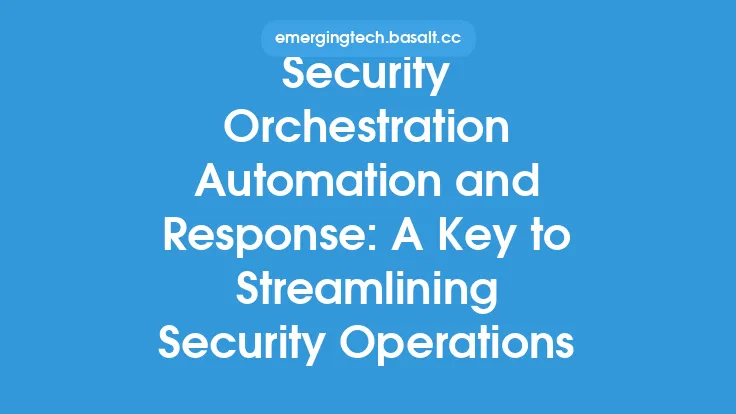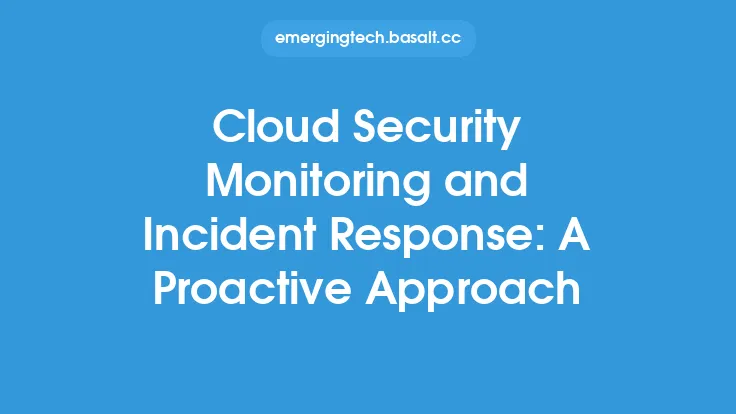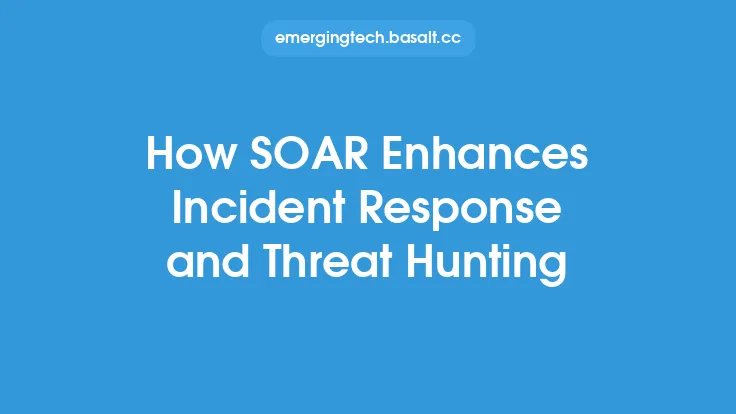Security Orchestration Automation and Response (SOAR) is a subset of the cybersecurity industry that focuses on the automation and streamlining of security operations. It is a technology solution that enables organizations to automate and orchestrate their security processes, improving the efficiency and effectiveness of their security teams. SOAR solutions are designed to help security teams manage the overwhelming volume of security-related data and alerts, and to respond quickly and effectively to security incidents.
Introduction to SOAR
SOAR solutions typically consist of three main components: security orchestration, automation, and response. Security orchestration refers to the process of integrating and coordinating different security tools and systems to provide a unified view of the security landscape. Automation refers to the use of software to automate repetitive and mundane security tasks, such as data collection and analysis. Response refers to the process of taking action in response to a security incident, such as containing and eradicating a threat.
Key Features of SOAR Solutions
SOAR solutions typically include a range of features, such as incident response playbooks, automation workflows, and integration with other security tools and systems. Incident response playbooks are pre-defined plans that outline the steps to be taken in response to a security incident. Automation workflows are automated processes that can be triggered in response to specific security events or incidents. Integration with other security tools and systems enables SOAR solutions to collect and analyze data from a range of sources, providing a comprehensive view of the security landscape.
How SOAR Works
SOAR solutions work by integrating with a range of security tools and systems, such as security information and event management (SIEM) systems, threat intelligence platforms, and vulnerability scanners. These tools and systems provide a constant stream of security-related data, which is collected and analyzed by the SOAR solution. The SOAR solution then uses this data to identify potential security incidents, and to trigger automated workflows and incident response playbooks. These workflows and playbooks are designed to automate and streamline the security response process, enabling security teams to respond quickly and effectively to security incidents.
Security Orchestration
Security orchestration is a critical component of SOAR solutions. It involves the integration and coordination of different security tools and systems to provide a unified view of the security landscape. Security orchestration enables organizations to automate and streamline their security processes, improving the efficiency and effectiveness of their security teams. It also enables organizations to respond quickly and effectively to security incidents, reducing the risk of data breaches and other security threats.
Automation
Automation is another key component of SOAR solutions. It involves the use of software to automate repetitive and mundane security tasks, such as data collection and analysis. Automation enables security teams to focus on higher-level tasks, such as threat hunting and incident response. It also enables organizations to respond quickly and effectively to security incidents, reducing the risk of data breaches and other security threats.
Response
Response is the final component of SOAR solutions. It involves the process of taking action in response to a security incident, such as containing and eradicating a threat. Response is critical to minimizing the impact of a security incident, and to preventing future incidents from occurring. SOAR solutions provide a range of response capabilities, including incident response playbooks and automation workflows. These capabilities enable security teams to respond quickly and effectively to security incidents, reducing the risk of data breaches and other security threats.
Benefits of SOAR
While the benefits of implementing SOAR in a cybersecurity strategy are numerous, the core functionality of SOAR solutions provides several advantages. For instance, SOAR solutions improve the efficiency and effectiveness of security teams by automating and streamlining security processes. They also enable organizations to respond quickly and effectively to security incidents, reducing the risk of data breaches and other security threats. Additionally, SOAR solutions provide a unified view of the security landscape, enabling security teams to make informed decisions about security operations.
Technical Requirements
From a technical perspective, SOAR solutions require a range of skills and expertise, including security orchestration, automation, and response. They also require a deep understanding of the security landscape, including the types of threats and vulnerabilities that organizations face. SOAR solutions must be able to integrate with a range of security tools and systems, including SIEM systems, threat intelligence platforms, and vulnerability scanners. They must also be able to automate and streamline security processes, improving the efficiency and effectiveness of security teams.
Implementation and Integration
Implementing and integrating a SOAR solution can be complex and challenging. It requires a deep understanding of the security landscape, as well as the technical skills and expertise to integrate the solution with other security tools and systems. Organizations must also develop incident response playbooks and automation workflows, which can be time-consuming and resource-intensive. However, the benefits of SOAR solutions make them a worthwhile investment for organizations looking to improve the efficiency and effectiveness of their security operations.
Common Use Cases
SOAR solutions are commonly used in a range of industries, including finance, healthcare, and government. They are used to automate and streamline security processes, improve incident response, and reduce the risk of data breaches and other security threats. SOAR solutions are also used to improve compliance with regulatory requirements, such as PCI-DSS and HIPAA. They provide a unified view of the security landscape, enabling security teams to make informed decisions about security operations.
Conclusion
In conclusion, Security Orchestration Automation and Response (SOAR) is a critical component of modern cybersecurity strategies. It enables organizations to automate and streamline their security processes, improving the efficiency and effectiveness of their security teams. SOAR solutions provide a range of benefits, including improved incident response, reduced risk of data breaches, and improved compliance with regulatory requirements. While implementing and integrating a SOAR solution can be complex and challenging, the benefits make it a worthwhile investment for organizations looking to improve their security operations.





